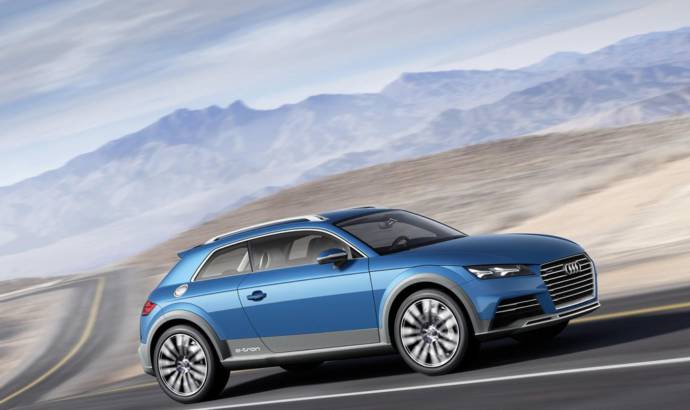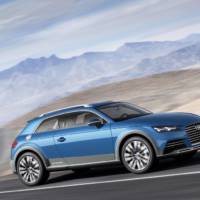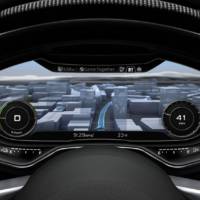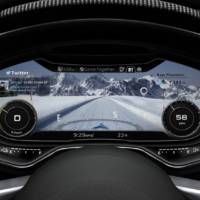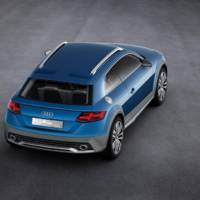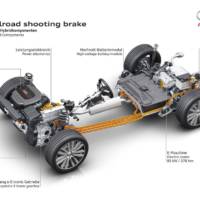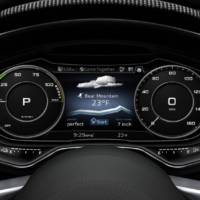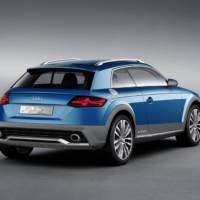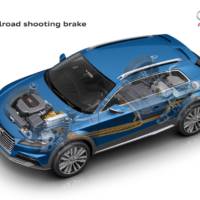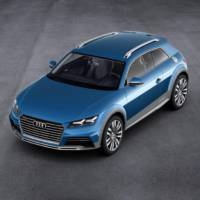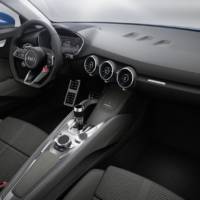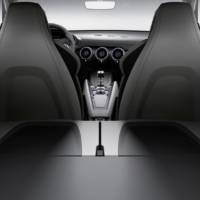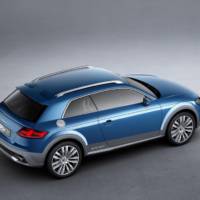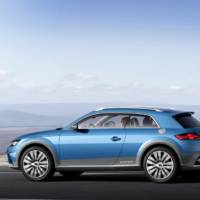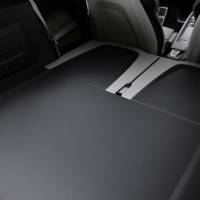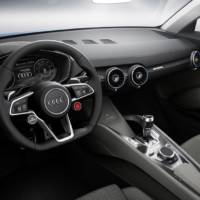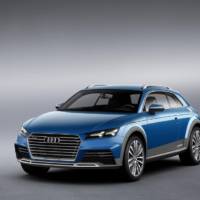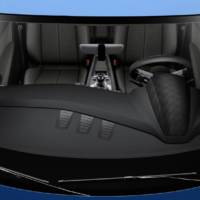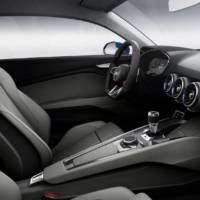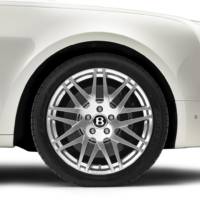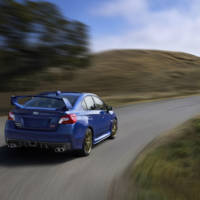Sporty, compact and versatile: It is with these attributes that the Audi allroad shooting brake makes its debut at the North American International Auto Show (NAIAS) in Detroit. The two-door car is a crossover and so it is not limited to paved roads. Its high level of functionality makes it ideal for recreational sports. Its hybrid drive, which is as powerful as it is efficient, makes a new form of quattro drive possible – the e-tron quattro.
The brand with the four rings is extending its design language in the Audi allroad shooting brake. The compact two-door show car combines a host of visual elements of future sports car models with the Audi-typical allroad concept and "shooting brake" car body form. Its user interface strategy also offers an outlook on future production solutions.
The Audi allroad shooting brake maintains a powerful stance on the road. The interplay of its cleanly drawn lines and the taut muscular tension of its surfaces create a sculptural, emotional design. The exterior skin appears as though it were sculpted from one solid piece, from the single-frame grille to the distinctive tornado line and crisp rear styling, in which the characteristics of the allroad and the shooting brake come together.
With a wheelbase of 2.51 meters (8.23 ft), the show car − painted in Ice Blue − is 4.20 meters (13.78 ft) long, 1.85 meters (6.07 ft) wide and 1.41 meters (4.63 ft) tall.
The Audi allroad shooting brake represents the first time that Audi has combined the allroad and e-tron form languages. As on every Audi, the large hexagonal single-frame grille dominates on the impressive sculptural front; it is slightly offset towards the rear of the body. Typical of an e-tron model, it has an insert with narrow fins, which resemble the cooling ribs of an electronic component. There is a quattro logo on the lower part of the single-frame. The low-profile central air inlet is milled into the underbody protection that is made of aluminum.
The low-profile dual headlights of the Audi allroad shooting brake are a classic reference to the form language of the Audi quattro models. At the same time, it represents an advanced development state of quattro design, which Audi already hinted at in the Sport quattro concept car in September 2013 at the IAA show in Frankfurt am Main. Braces partition the headlights into four segments; the matrix LED technology with its individually controlled light-emitting diodes guarantees excellent visibility without causing glare to oncoming traffic. Beneath the headlights, narrow cross fins provide structure to the large air inlets.
The exterior skin of the Audi allroad shooting brake is a material mix of aluminum and carbon fiber reinforced polymer (CFRP). The dark gray rub strips are typical allroad elements, and they visually reduce the volume of the body; they ascend dynamically from front to rear. Together with the large wheel flares, they highlight the car’s offroad character.
The versatility and functionality of the Audi allroad shooting brake is ideal for young, sporty and active people. In the winter in California, for example, they could drive the car from Los Angeles to the San Gabriel Mountains for snowboarding in the morning, and then head out to at Venice Beach for some kite surfing in the afternoon.
There is plenty of room for four passengers inside. In front, the narrow sport seats give the driver and front passenger optimal body support; they feature highly contoured lateral panels and integrated head restraints, while cushioned pads support the thighs in quick driving through curves. An easy entry function makes it easier to enter the rear seating area. When the rear seatback is folded down, a cargo area with a level cargo floor is created, in which there is space for rather large sports equipment.
Designed with clean and taut lines, the interior of the show car utilizes the colors anthracite and rock grey. The materials reflect the skillful handiwork of Audi designers – this is evident in the alcantara rooflining and in the various qualities of leather and the bright and dark aluminum materials that are used for controls and trim, e.g. on the air nozzles and the spokes of the multifunction steering wheel.
The interior design of the Audi allroad shooting brake also follows the Audi philosophy of lightweight design, sporty elegance and easy to use controls. When viewed from the top, the instrument panel resembles the wing surface of an airplane, and the round air nozzles elicit associations to jet engines. The controls for the climate control system are located here. Their center spindles contain the controls for seat heating, temperature and the direction and intensity of the air streams. They automatically extend out from the instrument panel when they sense a hand approaching. The lights are activated by a button, and a plate-type handle opens the door.
The new design of the MMI terminal and sporty design of the multifunction steering wheel lets the driver control nearly all functions of the Audi allroad shooting brake intuitively. The operating strategy imparts a new type of "joy of use" – the menu structure is based on that of a smart phone, which includes a free text search function. It is easy to access all major functions, and multitouch gestures on the touchpad of the MMI terminal enable quick scrolling and zooming in lists and maps.
The cockpit is very focused on the driver. The steering wheel and digital instrument cluster lie in a single direct line of sight. The TFT display with its 12.3 inch screen presents all key information in top quality 3D graphics and offers a variety of modes. In the classic view, the powermeter for the plug-in hybrid drive system and the speedometer are in the foreground, while in Infotainment mode elements such as the large navigation map dominate, and in Sport mode the tachometer is prominently displayed.
he 2.0 TFSI in the Audi allroad shooting brake outputs 215 kW (292 hp) of power and generates 380 Nm (280.27 lb-ft) of torque. The transverse mounted two-liter four-cylinder with a large turbocharger is a high-end engine. In part-load operation, indirect injection supplements direct gasoline injection to improve fuel economy; the exhaust manifold that is integrated in the cylinder head enables high-performance thermal management.
The 2.0 TFSI operates together with a disc-shaped electric motor via a decoupling clutch; the electric motor outputs 40 kW of power and 270 Nm (199.14 lb-ft) of torque. It is integrated in the six-speed e-S tronic. The dual clutch transmission, which shifts at lightning speed, sends torque to the front wheels.
A second electric motor, which is separate from this drive unit, is mounted to the rear axle. It supplies propulsive power at low and moderate vehicle speeds with its maximum power of 85 kW and 270 Nm (199.14 lb-ft) of torque. It can also be operated in tandem with the motor and engine at the front axle if the hybrid management system decides that all-wheel drive makes sense. In such situations, on a slippery road or in light off-road conditions, this essentially makes the Audi allroad shooting brake an e-tron quattro.
Depending on the driving situation, releasing the accelerator pedal can cause all drive units to be decoupled, or it can result in energy recovery by regenerative braking. In the first case, the show car coasts with zero emissions since the combustion engine is shut off; in the latter case, braking energy is fed back into the high-voltage battery.

